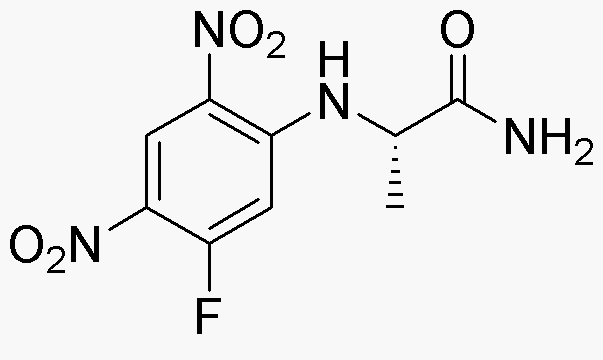Na-(2,4-Dinitro-5-fluorophenyl)-L-alanine amide is widely utilized in research focused on:
- Pharmaceutical Development: This compound serves as a key intermediate in the synthesis of various pharmaceuticals, particularly those targeting specific biological pathways. Its unique structure allows for the development of drugs with enhanced efficacy.
- Biochemical Research: Researchers use it to study protein interactions and enzyme activity due to its ability to modify amino acid structures, providing insights into metabolic processes.
- Analytical Chemistry: It is employed as a reagent in analytical methods, helping to detect and quantify other compounds in complex mixtures, which is essential for quality control in manufacturing.
- Agricultural Chemistry: The compound is explored for its potential use in developing agrochemicals, particularly as a pesticide or herbicide, due to its biological activity against pests.
- Material Science: It finds applications in creating specialized materials, such as polymers, that require specific chemical properties for enhanced performance in various industrial applications.
General Information
Properties
Safety and Regulations
Applications
Na-(2,4-Dinitro-5-fluorophenyl)-L-alanine amide is widely utilized in research focused on:
- Pharmaceutical Development: This compound serves as a key intermediate in the synthesis of various pharmaceuticals, particularly those targeting specific biological pathways. Its unique structure allows for the development of drugs with enhanced efficacy.
- Biochemical Research: Researchers use it to study protein interactions and enzyme activity due to its ability to modify amino acid structures, providing insights into metabolic processes.
- Analytical Chemistry: It is employed as a reagent in analytical methods, helping to detect and quantify other compounds in complex mixtures, which is essential for quality control in manufacturing.
- Agricultural Chemistry: The compound is explored for its potential use in developing agrochemicals, particularly as a pesticide or herbicide, due to its biological activity against pests.
- Material Science: It finds applications in creating specialized materials, such as polymers, that require specific chemical properties for enhanced performance in various industrial applications.
Documents
Safety Data Sheets (SDS)
The SDS provides comprehensive safety information on handling, storage, and disposal of the product.
Product Specification (PS)
The PS provides a comprehensive breakdown of the product’s properties, including chemical composition, physical state, purity, and storage requirements. It also details acceptable quality ranges and the product's intended applications.
Certificates of Analysis (COA)
Search for Certificates of Analysis (COA) by entering the products Lot Number. Lot and Batch Numbers can be found on a product’s label following the words ‘Lot’ or ‘Batch’.
Numéro de catalogue
Numéro de lot/série
Certificates Of Origin (COO)
This COO confirms the country where the product was manufactured, and also details the materials and components used in it and whether it is derived from natural, synthetic, or other specific sources. This certificate may be required for customs, trade, and regulatory compliance.
Numéro de catalogue
Numéro de lot/série
Safety Data Sheets (SDS)
The SDS provides comprehensive safety information on handling, storage, and disposal of the product.
DownloadProduct Specification (PS)
The PS provides a comprehensive breakdown of the product’s properties, including chemical composition, physical state, purity, and storage requirements. It also details acceptable quality ranges and the product's intended applications.
DownloadCertificates of Analysis (COA)
Search for Certificates of Analysis (COA) by entering the products Lot Number. Lot and Batch Numbers can be found on a product’s label following the words ‘Lot’ or ‘Batch’.
Numéro de catalogue
Numéro de lot/série
Certificates Of Origin (COO)
This COO confirms the country where the product was manufactured, and also details the materials and components used in it and whether it is derived from natural, synthetic, or other specific sources. This certificate may be required for customs, trade, and regulatory compliance.


